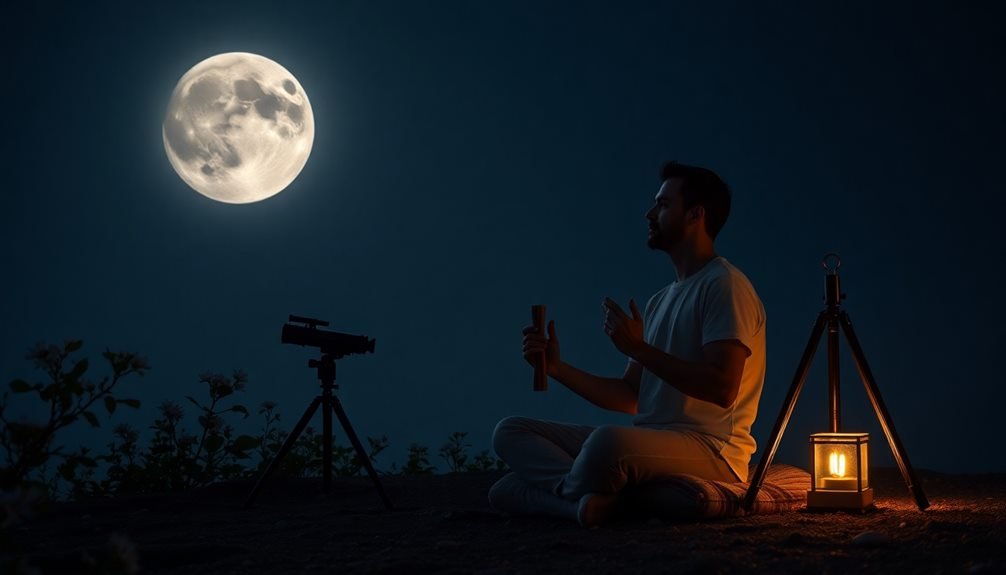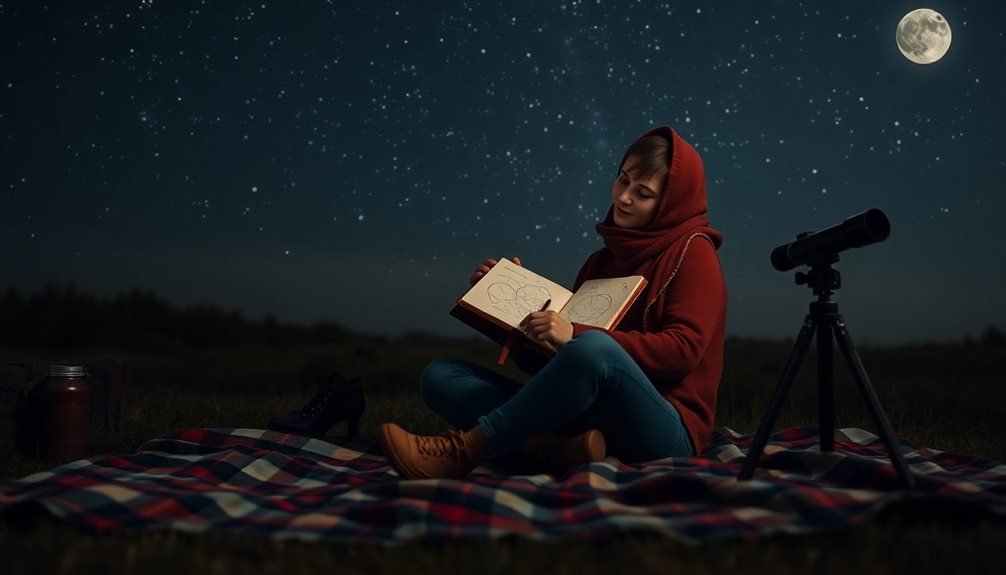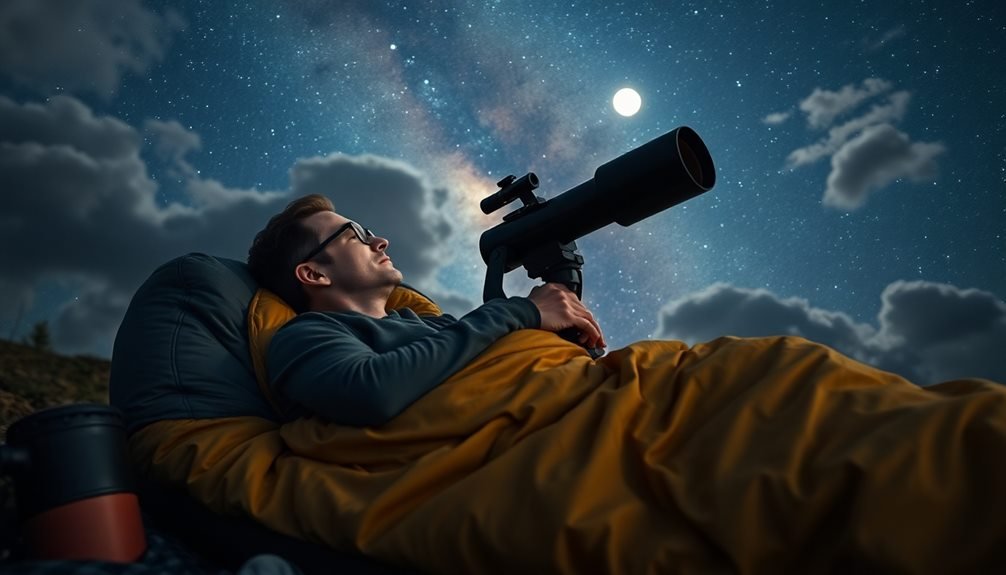Looking to ease your anxiety while stargazing? You'll find relief through three proven methods that combine astronomy with mindfulness. Start with mindful moon watching, where you'll use lunar features as anchors for focused breathing and stress reduction. Try deep space breathing exercises that sync your breath with the vastness of galaxies and star clusters, creating a profound sense of calm. For artistic expression, practice solo constellation sketching using a red-light pencil to document celestial patterns while cultivating mindfulness. Each method offers 10-15 minutes of therapeutic stargazing that can transform your astronomical pursuits into peaceful moments. Let these celestial techniques guide you toward tranquility among the stars.
Mindful Moon Watching

Gazing at the moon provides a natural anchor for mindfulness practice and stress relief. As Earth's only natural satellite moves through its phases, you'll find that tracking its steady rhythm can help regulate your breathing and calm your racing thoughts.
Position yourself comfortably, preferably in a reclining chair or on a blanket, and focus your attention on the moon's illuminated surface.
Begin by observing the moon's features – its craters, maria (dark plains), and the contrast between light and shadow. Notice how the lunar terminator, the line dividing light and dark sides, creates depth and dimension. You don't need any equipment for this practice, though binoculars can enhance the experience.
Breathe deeply as you scan the moon's surface, letting each breath sync with your visual exploration.
If anxious thoughts arise, acknowledge them and gently return your focus to the moon's steady presence. You'll find that the moon's predictable patterns and unchanging nature can ground you during stressful moments.
Practice this technique for 10-15 minutes, allowing the moon's serene glow to calm your nervous system and restore your sense of peace.
Deep Space Breathing Exercises
When the night sky beckons, deep space breathing exercises combine celestial observation with controlled respiration techniques. You'll want to find a comfortable position, either sitting or lying down, where you can clearly view the stars while maintaining relaxed breathing.
Start by focusing on a distant galaxy or star cluster while inhaling for four counts. As you breathe in, imagine drawing in the cosmic energy of that celestial object. Hold your breath for two counts while visualizing the vastness of space, then exhale for six counts as you mentally release any tension.
You can sync your breathing with slow scanning movements across star fields, inhaling as you move your gaze upward and exhaling as you pan downward.
For deeper relaxation, try the nebula breath technique: Choose a nebula or star-forming region visible through your telescope. As you breathe in, picture the swirling gases expanding, just as your lungs expand. When you exhale, imagine the cosmic dust settling peacefully, just as your body releases stress.
Practice this pattern for at least five minutes, allowing the rhythm of your breath to align with the serene nature of deep space.
Solo Constellation Sketching

Solo constellation sketching offers another meditative approach to stargazing, building on the calming effects of mindful observation. You'll need just a sketchbook, a red-light pencil, and a comfortable spot to sit while you trace the patterns above. As you focus on recreating celestial shapes, your mind naturally distances itself from daily stressors.
Begin with easily recognizable constellations like Orion or the Big Dipper. Don't worry about artistic perfection – your sketches are personal interpretations of the night sky. Draw connecting lines between stars first, then gradually add details about brightness and neighboring stars.
You'll notice your breathing slows as you alternate between looking up and marking your observations. Make notes about colors, relative positions, and any thoughts that arise during your sketching session.
This practice combines artistic expression with scientific observation, creating a mindful activity that grounds you in the present moment. Over time, you'll develop a personal star journal that tracks both celestial movements and your emotional journey.
Each sketch becomes a record of that specific night, capturing both the astronomical view and your state of mind.
Frequently Asked Questions
Can Stargazing With Pets Help Reduce Anxiety Levels During Astronomical Observations?
Yes, you'll find that stargazing with your pet can reduce anxiety. Their calming presence and companionship help you stay relaxed while observing the stars, though you'll need to make certain they're quiet and well-behaved.
What Weather Conditions Are Best for Stress-Free Nighttime Astronomy Sessions?
You'll find the most relaxing stargazing on clear, moonless nights with low humidity and minimal wind. Choose temperatures between 50-70°F when you're comfortable without worrying about being too hot or cold.
How Do Light-Polluted City Environments Affect Stargazing Meditation Effectiveness?
You'll find city light pollution diminishes meditation benefits by limiting visible stars and creating visual distractions. However, you can still practice mindful stargazing by focusing on brighter celestial objects that pierce through urban glare.
Which Telescope Magnifications Are Least Likely to Cause Eye Strain?
You'll find lower magnifications between 40x-100x are easiest on your eyes. Don't push beyond 200x unless necessary, as higher powers strain more. Start low and work up gradually as needed.
Are Group Stargazing Sessions More Beneficial for Anxiety Than Solitary Viewing?
You'll likely find group stargazing more calming since you're sharing the experience and reducing isolation. However, if you're highly anxious in social settings, solo viewing can be equally peaceful and therapeutic.
In Summary
You'll find these three stargazing techniques help calm your mind while deepening your connection to the cosmos. Whether you're tracking the moon's phases, syncing your breath with distant nebulae, or quietly sketching star patterns, you're creating moments of peace in the vastness of space. Don't let anxiety keep you from exploring the night sky – these mindful practices will transform your astronomical observations into therapeutic experiences.





Leave a Reply